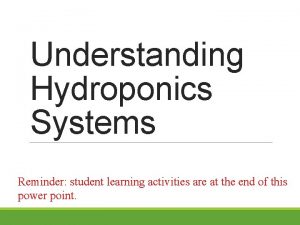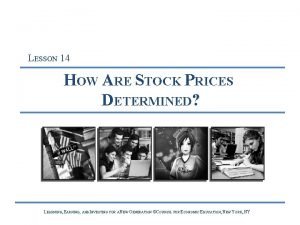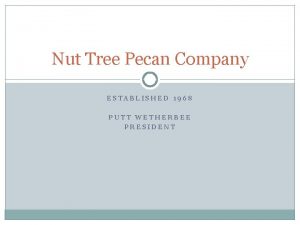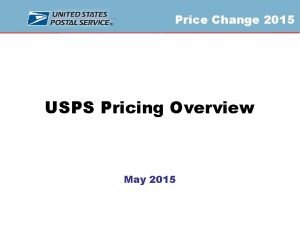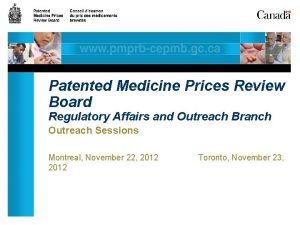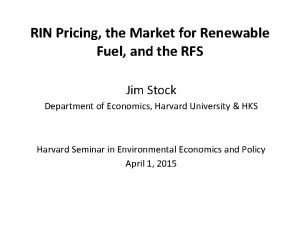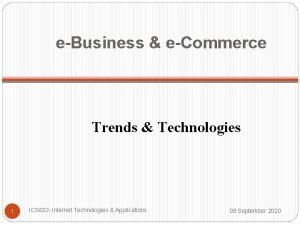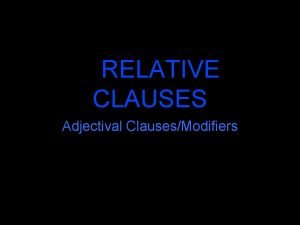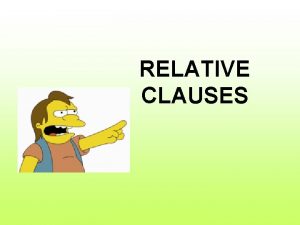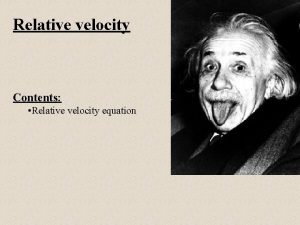IX Explaining Relative Prices 1 Explaining Relative Prices




































- Slides: 36

IX. Explaining Relative Prices 1

Explaining Relative Prices 1. CAPM – Capital Asset Pricing Model 2. Non Standard Forms of the CAPM 3. APT – Arbitrage Pricing Theory 2

Assumptions behind the CAPM 1. 2. 3. 4. 5. No transaction costs Assets are infinitely divisible No personal taxes Price Takers Investors look only at expected return and variances of their portfolio 6. Unlimited short sales 7. Unlimited lending and borrowing at the riskless Rate 8. Homogenous Expectations about time horizon 9. Homogenous expectations of expected return, variance, and covariance 10. All assets are marketable 3

Sharpe – Lintner – Mossine (CAPM) Two Approaches to deriving 1. Economic intuition 2. Rigorous analysis 4

5

6

A more rigorous proof Lintner Equation 7

Homogenous Expectations 8

Must hold for all securities and portfolios 9

Non standard forms of the CAPM If the CAPM does a good job of explaining return why bother 1. May do a better job 2. Even if the CAPM explains return; macro behavior might not explain micro behavior – e. g. , everybody does not hold market portfolio 3. If we don’t include influences in the model, e. g. , taxes we can’t study the impact of their influences on the model 10

Modification of assumptions 1. Short sales 2. Riskless lending and borrowing 3. Personal taxes 4. Non marketable assets 5. Heterogeneous expectations 6. Non price taking behavior 7. Multi period analysis 8. Consumption CAPM Rolls critique 11

Short Sales Since under the standard CAPM nobody short sells in equilibrium 12

13

14

Is a rate – such that if we could lend or borrow at it we would hold the market portfolio Lintner Equation But for zero beta so 15

16

by convexity of efficient frontier 17

is greater than 0 and smaller than 1 Global minimum variance involves positive investment in market and zero beta portfolios and therefore, expected return must be in between. 18

19

20

21

22

23

Non Marketable Assets CAPM With nonmarketable assets (H) Price of risk * amount of risk 24

Test of Equilibrium Models Expectations (1) Test with realizations – expectations are an average and on the whole correct Market Model Substitution 25

26

27

28

29

30

Fama and Mac Beth 1. 2. 3. Auto correlation of , , and , 31

32

33

34

Rolls Critique Mathematically can show for any efficient portfolio “Unfortunately it has never been subject to an unambiguous empirical test. There is considerable doubt…that it will be. ” 35

POST TAX CAPM 36
 Women anatomy
Women anatomy How to describe trends in graphs
How to describe trends in graphs Complex sentence starters
Complex sentence starters Understanding hydroponics
Understanding hydroponics Behavioural approach to explaining phobias
Behavioural approach to explaining phobias A pamphlet explaining how an unborn child
A pamphlet explaining how an unborn child Mowrer's two-process model of phobia
Mowrer's two-process model of phobia Explaining voltage
Explaining voltage Explaining deviance biological perspect
Explaining deviance biological perspect Explaining patterns hots
Explaining patterns hots What is the purpose of an explanation
What is the purpose of an explanation Templates for explaining quotations
Templates for explaining quotations Relative pronouns examples
Relative pronouns examples Relative pronouns and relative clauses
Relative pronouns and relative clauses Stage 15 relative clauses and relative pronouns
Stage 15 relative clauses and relative pronouns Conditional frequency table
Conditional frequency table Stock prices are determined by
Stock prices are determined by Springwest academy uniform price list
Springwest academy uniform price list Raymond xie
Raymond xie Axioms of urban economics
Axioms of urban economics Green tree pecan company
Green tree pecan company Steve keen house prices
Steve keen house prices Usps prices 2015
Usps prices 2015 Rising food prices causes and consequences
Rising food prices causes and consequences Costco pharmacy prices vs cvs
Costco pharmacy prices vs cvs Pmprb form 1
Pmprb form 1 Factors affecting option prices
Factors affecting option prices Flatbrook farm
Flatbrook farm How lower prices
How lower prices Southern timber prices
Southern timber prices Rena ware material
Rena ware material Solvay price increase
Solvay price increase Prices you can trust slogan
Prices you can trust slogan Rin prices
Rin prices Northcross ice skating
Northcross ice skating Ics internet prices
Ics internet prices Always low prices walmart
Always low prices walmart



